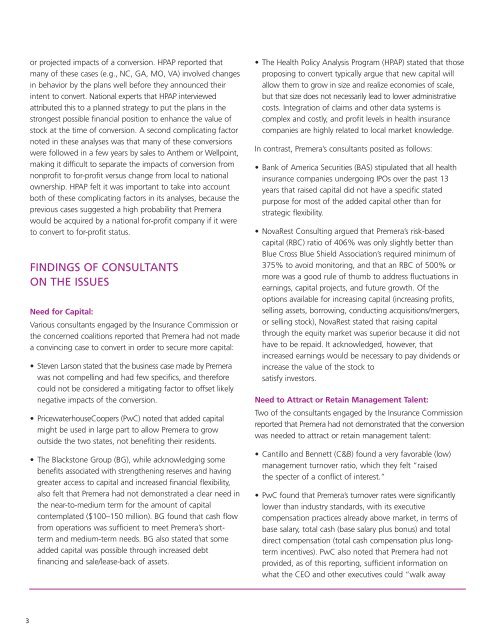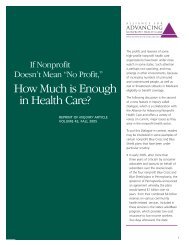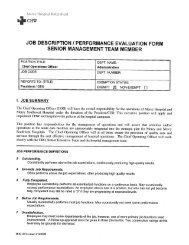Premera Blue Cross's Proposed Conversion to For-Profit Status
Premera Blue Cross's Proposed Conversion to For-Profit Status
Premera Blue Cross's Proposed Conversion to For-Profit Status
- No tags were found...
You also want an ePaper? Increase the reach of your titles
YUMPU automatically turns print PDFs into web optimized ePapers that Google loves.
or projected impacts of a conversion. HPAP reported thatmany of these cases (e.g., NC, GA, MO, VA) involved changesin behavior by the plans well before they announced theirintent <strong>to</strong> convert. National experts that HPAP interviewedattributed this <strong>to</strong> a planned strategy <strong>to</strong> put the plans in thestrongest possible financial position <strong>to</strong> enhance the value ofs<strong>to</strong>ck at the time of conversion. A second complicating fac<strong>to</strong>rnoted in these analyses was that many of these conversionswere followed in a few years by sales <strong>to</strong> Anthem or Wellpoint,making it difficult <strong>to</strong> separate the impacts of conversion fromnonprofit <strong>to</strong> for-profit versus change from local <strong>to</strong> nationalownership. HPAP felt it was important <strong>to</strong> take in<strong>to</strong> accountboth of these complicating fac<strong>to</strong>rs in its analyses, because theprevious cases suggested a high probability that <strong>Premera</strong>would be acquired by a national for-profit company if it were<strong>to</strong> convert <strong>to</strong> for-profit status.FINDINGS OF CONSULTANTSON THE ISSUESNeed for Capital:Various consultants engaged by the Insurance Commission orthe concerned coalitions reported that <strong>Premera</strong> had not madea convincing case <strong>to</strong> convert in order <strong>to</strong> secure more capital:• Steven Larson stated that the business case made by <strong>Premera</strong>was not compelling and had few specifics, and thereforecould not be considered a mitigating fac<strong>to</strong>r <strong>to</strong> offset likelynegative impacts of the conversion.• PricewaterhouseCoopers (PwC) noted that added capitalmight be used in large part <strong>to</strong> allow <strong>Premera</strong> <strong>to</strong> growoutside the two states, not benefiting their residents.• The Blacks<strong>to</strong>ne Group (BG), while acknowledging somebenefits associated with strengthening reserves and havinggreater access <strong>to</strong> capital and increased financial flexibility,also felt that <strong>Premera</strong> had not demonstrated a clear need inthe near-<strong>to</strong>-medium term for the amount of capitalcontemplated ($100–150 million). BG found that cash flowfrom operations was sufficient <strong>to</strong> meet <strong>Premera</strong>’s shorttermand medium-term needs. BG also stated that someadded capital was possible through increased debtfinancing and sale/lease-back of assets.• The Health Policy Analysis Program (HPAP) stated that thoseproposing <strong>to</strong> convert typically argue that new capital willallow them <strong>to</strong> grow in size and realize economies of scale,but that size does not necessarily lead <strong>to</strong> lower administrativecosts. Integration of claims and other data systems iscomplex and costly, and profit levels in health insurancecompanies are highly related <strong>to</strong> local market knowledge.In contrast, <strong>Premera</strong>’s consultants posited as follows:• Bank of America Securities (BAS) stipulated that all healthinsurance companies undergoing IPOs over the past 13years that raised capital did not have a specific statedpurpose for most of the added capital other than forstrategic flexibility.• NovaRest Consulting argued that <strong>Premera</strong>’s risk-basedcapital (RBC) ratio of 406% was only slightly better than<strong>Blue</strong> Cross <strong>Blue</strong> Shield Association’s required minimum of375% <strong>to</strong> avoid moni<strong>to</strong>ring, and that an RBC of 500% ormore was a good rule of thumb <strong>to</strong> address fluctuations inearnings, capital projects, and future growth. Of theoptions available for increasing capital (increasing profits,selling assets, borrowing, conducting acquisitions/mergers,or selling s<strong>to</strong>ck), NovaRest stated that raising capitalthrough the equity market was superior because it did nothave <strong>to</strong> be repaid. It acknowledged, however, thatincreased earnings would be necessary <strong>to</strong> pay dividends orincrease the value of the s<strong>to</strong>ck <strong>to</strong>satisfy inves<strong>to</strong>rs.Need <strong>to</strong> Attract or Retain Management Talent:Two of the consultants engaged by the Insurance Commissionreported that <strong>Premera</strong> had not demonstrated that the conversionwas needed <strong>to</strong> attract or retain management talent:• Cantillo and Bennett (C&B) found a very favorable (low)management turnover ratio, which they felt “raisedthe specter of a conflict of interest.”• PwC found that <strong>Premera</strong>’s turnover rates were significantlylower than industry standards, with its executivecompensation practices already above market, in terms ofbase salary, <strong>to</strong>tal cash (base salary plus bonus) and <strong>to</strong>taldirect compensation (<strong>to</strong>tal cash compensation plus longtermincentives). PwC also noted that <strong>Premera</strong> had notprovided, as of this reporting, sufficient information onwhat the CEO and other executives could “walk away3







